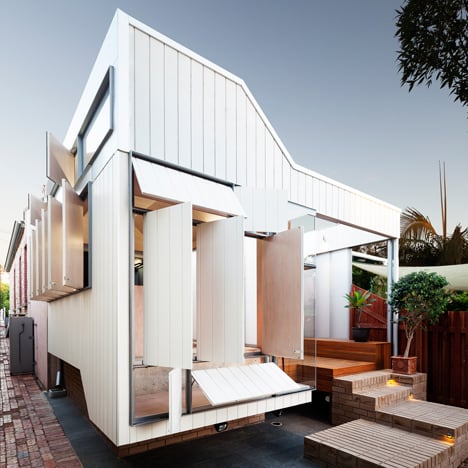Australian studio Philip Stejskal Architecture has equipped a white timber extension to a 1890s duplex with shutters and sliding panels that camouflage with the walls when closed.
Philip Stejskal Architecture extended a 19th century house in Fremantle, western Australia, named Bellevue Terrace. The firm added an enclosed terrace containing an open-air dining room, a small bathroom, and a pathway connecting the two spaces.
The Perth-based office carried out the alterations and additions to bridge a 1.5-metre level difference between the rear of the property and the garden, adding three platforms in contrasting materials to create a space for residents to "loiter".
The stepped terraces, which transition from brick to timber and then to concrete, were designed to offer "varying degrees of nearness to the outside".
"The brief was to forge a new relationship with the outside, and to replace an existing deck and pergola with a flexible space that was neither fully internal nor external," Philip Stejskal told Dezeen.
"The owners are given various opportunities to loiter along the way, to sit on edges of platforms and steps… to choose their condition of nearness to the outside or inside."
The exterior of the building is clad in a mixture of white-painted timber that differentiates the extension from the limestone walls of the existing cottage.
Hatches in the cladding pivot open to ventilate and light the interior space. The shutters are made up of two layers – an external skin that blends with the cladding when closed, and a internal layer of plywood that tones with the timber-lined living space.
"The opening panels allow the extension to breathe and give the owners control over their interaction with the immediate environment," said Stejskal.
"When closed, we wanted the addition to appear in lock-down – the hinged panels almost blending into the skin. When open, the continuity of the vertical grooves is distinctly broken, emphasising this configuration."
A glazed corner and high-level strip window puncture the lime-washed plywood walls, allowing some natural light to enter the concrete-floored living space when the hatches are closed.
Beside the living room, an area of decking made from tallowwood – a type of eucalyptus indigenous to New South Wales – leads down through a sliding door onto a brick plinth and into the garden.
The decked area, which has a wooden-clad bathroom in one corner, is partially enclosed. This creates the outdoor dining area.
"The timber terrace is like a bridge connecting the brick outcrop and the original house," he said.
The project won the Australian Institute of Architects Award for Residential Architecture.
Photography is by Bo Wong.

